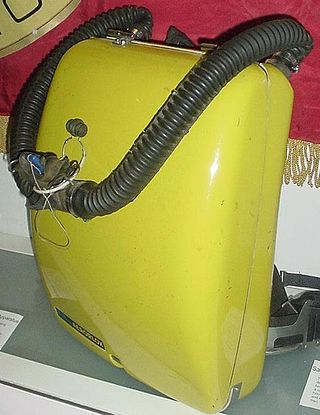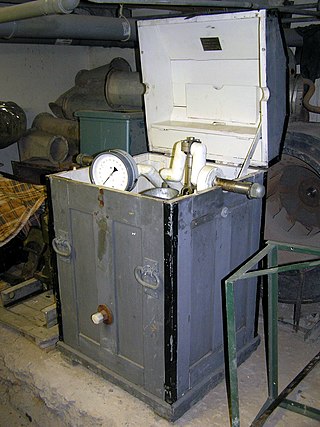The timeline of underwater diving technology is a chronological list of notable events in the history of the development of underwater diving equipment. With the partial exception of breath-hold diving, the development of underwater diving capacity, scope, and popularity, has been closely linked to available technology, and the physiological constraints of the underwater environment.

The Royal Society for the Encouragement of Arts, Manufactures and Commerce, commonly known as the Royal Society of Arts (RSA), is a London-based organisation.

A rebreather is a breathing apparatus that absorbs the carbon dioxide of a user's exhaled breath to permit the rebreathing (recycling) of the substantially unused oxygen content, and unused inert content when present, of each breath. Oxygen is added to replenish the amount metabolised by the user. This differs from open-circuit breathing apparatus, where the exhaled gas is discharged directly into the environment. The purpose is to extend the breathing endurance of a limited gas supply, while also eliminating the bubbles otherwise produced by an open circuit system. The latter advantage over other systems is useful for covert military operations by frogmen, as well as for undisturbed observation of underwater wildlife. A rebreather is generally understood to be a portable apparatus carried by the user. The same technology on a vehicle or non-mobile installation is more likely to be referred to as a life-support system.

A diving suit is a garment or device designed to protect a diver from the underwater environment. A diving suit may also incorporate a breathing gas supply, but in most cases the term applies only to the environmental protective covering worn by the diver. The breathing gas supply is usually referred to separately. There is no generic term for the combination of suit and breathing apparatus alone. It is generally referred to as diving equipment or dive gear along with any other equipment necessary for the dive.

Standard diving dress, also known as hard-hat or copper hat equipment, deep sea diving suit or heavy gear, is a type of diving suit that was formerly used for all relatively deep underwater work that required more than breath-hold duration, which included marine salvage, civil engineering, pearl shell diving and other commercial diving work, and similar naval diving applications. Standard diving dress has largely been superseded by lighter and more comfortable equipment.

A diving helmet is a rigid head enclosure with a breathing gas supply used in underwater diving. They are worn mainly by professional divers engaged in surface-supplied diving, though some models can be used with scuba equipment. The upper part of the helmet, known colloquially as the hat or bonnet, may be sealed directly to the diver using a neck dam, connected to a diving suit by a lower part, known as a breastplate, or corselet, depending on regional language preferences, or simply rest on the diver's shoulders, with an open bottom, for shallow water use.

A full-face diving mask is a type of diving mask that seals the whole of the diver's face from the water and contains a mouthpiece, demand valve or constant flow gas supply that provides the diver with breathing gas. The full face mask has several functions: it lets the diver see clearly underwater, it provides the diver's face with some protection from cold and polluted water and from stings, such as from jellyfish or coral. It increases breathing security and provides a space for equipment that lets the diver communicate with the surface support team.

The Clearance Divers Breathing Apparatus (CDBA) is a type of rebreather made by Siebe Gorman in England.

Siebe Gorman & Company Ltd was a British company that developed diving equipment and breathing equipment and worked on commercial diving and marine salvage projects. The company advertised itself as 'Submarine Engineers'. It was founded by Augustus Siebe, a German-born British engineer chiefly known for his contributions to diving equipment.

John Scott Haldane was a Scottish physician physiologist and philosopher famous for intrepid self-experimentation which led to many important discoveries about the human body and the nature of gases. He also experimented on his son, the celebrated and polymathic biologist J. B. S. Haldane, even when he was quite young. Haldane locked himself in sealed chambers breathing potentially lethal cocktails of gases while recording their effect on his mind and body.
Heinke was a series of companies that made diving equipment in London, run by members of a Heinke family.

Sir Leonard Erskine Hill FRS was a British physiologist. He was elected a Fellow of the Royal Society in 1900 and was knighted in 1930. One of his sons was the epidemiologist and statistician Austin Bradford Hill. His father was George Birkbeck Hill, the famous scholar and commentator on the works of Samuel Johnson, who at the time of his birth was headmaster of Bruce Castle School.

A diver's pump is a manually operated low pressure air compressor used to provide divers in standard diving dress with air while they are underwater.

Vintage scuba is scuba equipment dating from 1975 and earlier, and the practice of diving using such equipment.

Charles Anthony Deane (1796–1848) was a pioneering diving engineer, inventor of the diving helmet.

August Denayrouze (1837–1883) was an inventor of a demand valve for control of breathing air supply, and one of the inventors of a diving suit, along with Benoît Rouquayrol.

The history of underwater diving starts with freediving as a widespread means of hunting and gathering, both for food and other valuable resources such as pearls and coral. By classical Greek and Roman times commercial applications such as sponge diving and marine salvage were established. Military diving also has a long history, going back at least as far as the Peloponnesian War, with recreational and sporting applications being a recent development. Technological development in ambient pressure diving started with stone weights (skandalopetra) for fast descent. In the 16th and 17th centuries diving bells became functionally useful when a renewable supply of air could be provided to the diver at depth, and progressed to surface-supplied diving helmets—in effect miniature diving bells covering the diver's head and supplied with compressed air by manually operated pumps—which were improved by attaching a waterproof suit to the helmet and in the early 19th century became the standard diving dress.

















